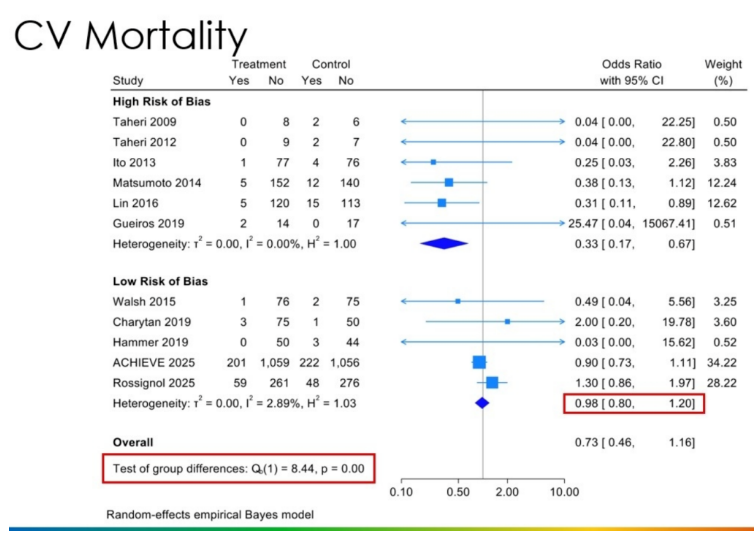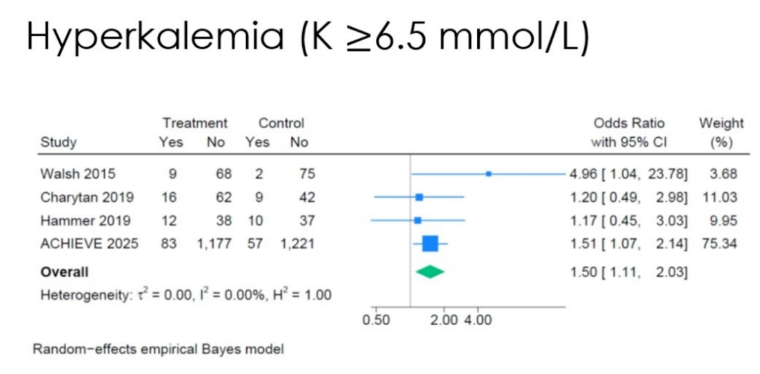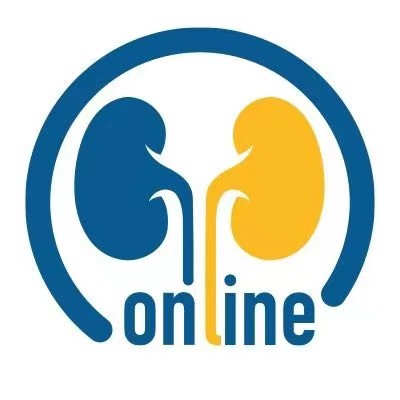- 首页 > 正文
透析患者使用盐皮质激素受体拮抗剂:疗效争议与研究新方向 | ERA大咖谈
发表时间:2025-08-19 15:49:58
编者按:在第62届欧洲肾脏协会年会上,加拿大麦克马斯特大学的Lonnie Pyne博士报告了其最新的系统评价和荟萃分析结果,该研究探讨了盐皮质激素受体拮抗剂(MRA)在需要透析的肾衰竭患者中的疗效。肾医线特邀Lonnie Pyne博士就此内容进行了深入分析。
肾医线:您的最新系统评价和荟萃分析聚焦于透析患者使用盐皮质激素受体拮抗剂的情况。从最新证据中,您观察到的最重要发现或趋势是什么?
Pyne博士:我们原本希望发现这类药物能降低心血管死亡率。但遗憾的是,与此前关于该主题的系统评价和荟萃分析结果相反,我们发现对于需要透析的肾衰竭患者,盐皮质激素受体拮抗剂并未降低心血管死亡风险,也未降低全因死亡率或心力衰竭住院率。从疗效来看,这类药物并无获益未显示出益处,反而带来了一些相关副作用,尤其是高钾血症发生率增加。我们将高钾血症定义为血钾≥6.5 mmol/L,其优势比约为1.5,即风险增加约50%;此外,男性乳房发育或乳房胀痛的发生率增加了3~3.5倍。而对于这一患者群体而言,盐皮质激素受体拮抗剂并未带来真正能抵消这些副作用的益处。
Nephrology On-line: Your updated systematic review and meta-analysis focus on mineralocorticoid receptor antagonists in dialysis patients. What are the most significant findings or trends you observed from the latest evidence?
Dr Pyne: We were hoping to find that they would lower cardiovascular mortality. Unfortunately, what we found was that in contrast to the prior systematic reviews and meta-analyses on this topic, mineralocorticoid receptor antagonists in patients with kidney failure requiring dialysis did not lower the rates of cardiovascular death, did not lower the rates of overall all-cause mortality, and did not lower the rates of heart failure hospitalization. So, in terms of efficacy, they were not found to be beneficial, and did have some relevant side effects, particularly increasing the rates of hyperkalemia. We defined hyperkalemia as potassium greater than or equal to 6.5. Odds ratio for that was about 1.5, so an approximately 50% increase, as well as a three to three-and-a-half times increase in the rate of gynecomastia or breast tenderness. So, some relevant side effects, but no really offsetting beneficial effects of mineralocorticoid receptor antagonists in this patient population.
肾医线:这些发现对当前肾衰竭透析患者的临床指南或治疗决策有何影响?
Pyne博士:至少在我的临床实践中,我并不会常规地对所有需要透析的终末期肾病患者使用盐皮质激素受体拮抗剂,临床实践指南中也未作此推荐。因此,这些发现与我的临床实践一致,即不常规推荐使用此类药物来降低心血管事件风险,同时也需考虑其显著的副作用。不过,对于存在其他适应证的患者(例如射血分数降低的心力衰竭患者),不应以此研究结果作为反对使用盐皮质激素受体拮抗剂的证据。这一结论仅针对未筛选的终末期肾病透析患者,我将继续保持不常规使用此类药物的临床实践。
Nephrology On-line: How do these findings influence current clinical guidelines or treatment decisions for patients with kidney failure on dialysis?
Dr Pyne: I think right now, at least in my own personal practice, I was not routinely using mineralocorticoid receptor antagonists for an unselected patient population with end-stage renal disease requiring dialysis, and nor was that something that was recommended in clinical practice guidelines. So, I think, in that sense, my own personal clinical practice would be pretty consistent, which is to say that they would not be recommended routinely to lower the risk of cardiovascular events, and also considering the important side effects profile there. Now, outside of that patient population, should they have another indication for mineralocorticoid receptor antagonists, if they have heart failure with reduced ejection fraction for example, I don't think this should be used as evidence to counteract that. This is merely saying, in an unselected patient population of end-stage renal disease requiring dialysis, I was not routinely using mineralocorticoid receptor antagonists and that will continue to be my practice.
肾医线:基于您的分析,该人群中盐皮质激素受体拮抗剂的安全性和有效性研究仍存在哪些空白?未来研究应优先关注哪些方向?
Pyne博士:我们的系统评价关注的是针对需要透析人群使用任何类型盐皮质激素受体拮抗剂(MRA)的随机对照试验。但我们发现,所有纳入的试验都仅使用了甾体类盐皮质激素受体拮抗剂。除了一项研究使用依普利酮外,其余均采用螺内酯 —— 这两种药物都属于甾体类 MRA。
在我看来,当前最明显的研究空白在于:非甾体类盐皮质激素受体拮抗剂的效果如何? 这类药物在透析患者中是否存在不同作用,是一个值得特别关注的领域。目前,至少在北美,可用的非甾体类MRA为非奈利酮,但它尚未获批用于需要透析的肾衰竭患者,这无疑是最关键的研究缺口之一。
此外,还有一些更重要的问题亟待解决:如何选择合适的临床终点?在需要透析的终末期肾病患者中,该如何定义 “心力衰竭住院”?我们是否需要对心血管终点进行更细致的分类?当前多数试验仅关注总体心血管死亡率,其中既包括心律失常、心源性猝死、心力衰竭等心脏事件,也混杂了心脏病发作、中风等血管事件。而 MRA 对这两类事件的影响是否存在差异,我认为值得深入探究。
Nephrology On-line: Based on your analysis, what are the remaining gaps in research regarding the safety and efficacy of mineralocorticoid receptor antagonists in this population, and what should future studies prioritize?
Dr Pyne: That's a great question. As mentioned, our systematic review was looking at randomized controlled trials of any type of mineralocorticoid receptor antagonists in people requiring dialysis. We only found trials using steroidal mineralocorticoid receptor antagonists. All of the studies, except for one, were of spironolactone. One was of eplerenone. Both spironolactone and eplerenone are steroidal mineralocorticoid receptor antagonists. So, to me, the most glaring gap would be what effect do non-steroidal mineralocorticoid receptor antagonists have? Whether or not there is a different effect in this patient population would be an area that I think would be of particular interest. Currently, at least in North America, the available non-steroidal mineralocorticoid receptor antagonist is finerenone but it is not approved for patients with kidney failure requiring dialysis. I think that would be one of the most relevant gaps. Then the bigger questions are what outcomes to use, how to define heart failure hospitalization in patients with end-stage disease requiring dialysis, and whether we need to be more narrow for our cardiovascular outcomes. Most of the trials looked at overall cardiovascular mortality, which includes cardiac events of arrhythmias and sudden cardiac death and heart failure, but also lumps vascular events in together, like heart attacks and strokes. Whether or not mineralocorticoid receptor antagonists affect those two types of events differently would, I think, be worth looking into.
报告概要
盐皮质激素受体拮抗剂在接受透析的肾衰竭患者中的应用:一项最新系统评价和荟萃分析
研究背景:透析患者心血管风险与MRA的应用争议
终末期肾病患者常伴随高发心血管事件,而盐皮质激素受体拮抗剂(MRAs)在慢性心力衰竭和慢性肾病(CKD)患者中已被证实可降低心血管风险。然而,这类药物在需要透析的肾衰竭患者中的疗效与安全性一直存在争议。
研究方法:纳入19项研究的全面证据整合
研究团队检索了截至2025年3月的MEDLINE、Embase等数据库,纳入19项随机对照试验(RCT),覆盖接受维持性透析(血液透析或腹膜透析)的成年患者,比较MRA(如螺内酯、依普利酮)与安慰剂/标准治疗的疗效与安全性。主要终点包括心血管死亡、心力衰竭住院、全因死亡,次要终点涉及高钾血症、男性乳房发育等不良反应。研究采用GRADE方法评估证据确定性,并通过随机效应模型分析异质性。
关键结果:MRA未带来生存获益,副作用显著
1.心血管与全因死亡无改善:
低偏倚风险研究显示,MRA组心血管死亡风险比(OR)为0.98(95%CI:0.80~1.20)(图1),全因死亡OR为0.97(0.84~1.21),均无统计学意义。高偏倚风险研究中,MRA虽显示心血管死亡风险降低(OR 0.33,0.17~0.67),但整体证据指向中性结果。
全因住院率亦无显著差异(OR 0.97,0.83~1.14)。

图1. 心血管死亡
2.心力衰竭住院:信号不确定
仅2项低偏倚研究分析显示,MRA组心力衰竭住院OR为0.70(0.30~1.65),但异质性较高(I2=71.1%),证据确定性低。
3.安全性问题:高钾血症与乳房不良反应突出
高钾血症(血钾≥6.5 mmol/L)风险增加50%(OR 1.50,1.11~2.03),绝对风险增加23/1000人。
男性乳房发育或乳房疼痛风险显著升高3.66倍(OR 3.66,1.82~7.36),绝对风险增加13/1000人。
低血压风险无显著变化(OR 1.04,0.61~1.78)。

图2. 高钾血症情况
证据分级:中等确定性支持MRA的风险警示
GRADE评估显示,心血管死亡、全因死亡证据为中等确定性,高钾血症和乳房不良反应为中等确定性,心力衰竭住院为低确定性。研究指出,现有证据均来自甾体类MRA(如螺内酯、依普利酮),非甾体类MRA(如非奈利酮)在透析患者中的数据完全缺失。
肾医线:您的最新系统评价和荟萃分析聚焦于透析患者使用盐皮质激素受体拮抗剂的情况。从最新证据中,您观察到的最重要发现或趋势是什么?
Pyne博士:我们原本希望发现这类药物能降低心血管死亡率。但遗憾的是,与此前关于该主题的系统评价和荟萃分析结果相反,我们发现对于需要透析的肾衰竭患者,盐皮质激素受体拮抗剂并未降低心血管死亡风险,也未降低全因死亡率或心力衰竭住院率。从疗效来看,这类药物并无获益未显示出益处,反而带来了一些相关副作用,尤其是高钾血症发生率增加。我们将高钾血症定义为血钾≥6.5 mmol/L,其优势比约为1.5,即风险增加约50%;此外,男性乳房发育或乳房胀痛的发生率增加了3~3.5倍。而对于这一患者群体而言,盐皮质激素受体拮抗剂并未带来真正能抵消这些副作用的益处。
Nephrology On-line: Your updated systematic review and meta-analysis focus on mineralocorticoid receptor antagonists in dialysis patients. What are the most significant findings or trends you observed from the latest evidence?
Dr Pyne: We were hoping to find that they would lower cardiovascular mortality. Unfortunately, what we found was that in contrast to the prior systematic reviews and meta-analyses on this topic, mineralocorticoid receptor antagonists in patients with kidney failure requiring dialysis did not lower the rates of cardiovascular death, did not lower the rates of overall all-cause mortality, and did not lower the rates of heart failure hospitalization. So, in terms of efficacy, they were not found to be beneficial, and did have some relevant side effects, particularly increasing the rates of hyperkalemia. We defined hyperkalemia as potassium greater than or equal to 6.5. Odds ratio for that was about 1.5, so an approximately 50% increase, as well as a three to three-and-a-half times increase in the rate of gynecomastia or breast tenderness. So, some relevant side effects, but no really offsetting beneficial effects of mineralocorticoid receptor antagonists in this patient population.
肾医线:这些发现对当前肾衰竭透析患者的临床指南或治疗决策有何影响?
Pyne博士:至少在我的临床实践中,我并不会常规地对所有需要透析的终末期肾病患者使用盐皮质激素受体拮抗剂,临床实践指南中也未作此推荐。因此,这些发现与我的临床实践一致,即不常规推荐使用此类药物来降低心血管事件风险,同时也需考虑其显著的副作用。不过,对于存在其他适应证的患者(例如射血分数降低的心力衰竭患者),不应以此研究结果作为反对使用盐皮质激素受体拮抗剂的证据。这一结论仅针对未筛选的终末期肾病透析患者,我将继续保持不常规使用此类药物的临床实践。
Nephrology On-line: How do these findings influence current clinical guidelines or treatment decisions for patients with kidney failure on dialysis?
Dr Pyne: I think right now, at least in my own personal practice, I was not routinely using mineralocorticoid receptor antagonists for an unselected patient population with end-stage renal disease requiring dialysis, and nor was that something that was recommended in clinical practice guidelines. So, I think, in that sense, my own personal clinical practice would be pretty consistent, which is to say that they would not be recommended routinely to lower the risk of cardiovascular events, and also considering the important side effects profile there. Now, outside of that patient population, should they have another indication for mineralocorticoid receptor antagonists, if they have heart failure with reduced ejection fraction for example, I don't think this should be used as evidence to counteract that. This is merely saying, in an unselected patient population of end-stage renal disease requiring dialysis, I was not routinely using mineralocorticoid receptor antagonists and that will continue to be my practice.
肾医线:基于您的分析,该人群中盐皮质激素受体拮抗剂的安全性和有效性研究仍存在哪些空白?未来研究应优先关注哪些方向?
Pyne博士:我们的系统评价关注的是针对需要透析人群使用任何类型盐皮质激素受体拮抗剂(MRA)的随机对照试验。但我们发现,所有纳入的试验都仅使用了甾体类盐皮质激素受体拮抗剂。除了一项研究使用依普利酮外,其余均采用螺内酯 —— 这两种药物都属于甾体类 MRA。
在我看来,当前最明显的研究空白在于:非甾体类盐皮质激素受体拮抗剂的效果如何? 这类药物在透析患者中是否存在不同作用,是一个值得特别关注的领域。目前,至少在北美,可用的非甾体类MRA为非奈利酮,但它尚未获批用于需要透析的肾衰竭患者,这无疑是最关键的研究缺口之一。
此外,还有一些更重要的问题亟待解决:如何选择合适的临床终点?在需要透析的终末期肾病患者中,该如何定义 “心力衰竭住院”?我们是否需要对心血管终点进行更细致的分类?当前多数试验仅关注总体心血管死亡率,其中既包括心律失常、心源性猝死、心力衰竭等心脏事件,也混杂了心脏病发作、中风等血管事件。而 MRA 对这两类事件的影响是否存在差异,我认为值得深入探究。
Nephrology On-line: Based on your analysis, what are the remaining gaps in research regarding the safety and efficacy of mineralocorticoid receptor antagonists in this population, and what should future studies prioritize?
Dr Pyne: That's a great question. As mentioned, our systematic review was looking at randomized controlled trials of any type of mineralocorticoid receptor antagonists in people requiring dialysis. We only found trials using steroidal mineralocorticoid receptor antagonists. All of the studies, except for one, were of spironolactone. One was of eplerenone. Both spironolactone and eplerenone are steroidal mineralocorticoid receptor antagonists. So, to me, the most glaring gap would be what effect do non-steroidal mineralocorticoid receptor antagonists have? Whether or not there is a different effect in this patient population would be an area that I think would be of particular interest. Currently, at least in North America, the available non-steroidal mineralocorticoid receptor antagonist is finerenone but it is not approved for patients with kidney failure requiring dialysis. I think that would be one of the most relevant gaps. Then the bigger questions are what outcomes to use, how to define heart failure hospitalization in patients with end-stage disease requiring dialysis, and whether we need to be more narrow for our cardiovascular outcomes. Most of the trials looked at overall cardiovascular mortality, which includes cardiac events of arrhythmias and sudden cardiac death and heart failure, but also lumps vascular events in together, like heart attacks and strokes. Whether or not mineralocorticoid receptor antagonists affect those two types of events differently would, I think, be worth looking into.
报告概要
盐皮质激素受体拮抗剂在接受透析的肾衰竭患者中的应用:一项最新系统评价和荟萃分析
研究背景:透析患者心血管风险与MRA的应用争议
终末期肾病患者常伴随高发心血管事件,而盐皮质激素受体拮抗剂(MRAs)在慢性心力衰竭和慢性肾病(CKD)患者中已被证实可降低心血管风险。然而,这类药物在需要透析的肾衰竭患者中的疗效与安全性一直存在争议。
研究方法:纳入19项研究的全面证据整合
研究团队检索了截至2025年3月的MEDLINE、Embase等数据库,纳入19项随机对照试验(RCT),覆盖接受维持性透析(血液透析或腹膜透析)的成年患者,比较MRA(如螺内酯、依普利酮)与安慰剂/标准治疗的疗效与安全性。主要终点包括心血管死亡、心力衰竭住院、全因死亡,次要终点涉及高钾血症、男性乳房发育等不良反应。研究采用GRADE方法评估证据确定性,并通过随机效应模型分析异质性。
关键结果:MRA未带来生存获益,副作用显著
1.心血管与全因死亡无改善:
低偏倚风险研究显示,MRA组心血管死亡风险比(OR)为0.98(95%CI:0.80~1.20)(图1),全因死亡OR为0.97(0.84~1.21),均无统计学意义。高偏倚风险研究中,MRA虽显示心血管死亡风险降低(OR 0.33,0.17~0.67),但整体证据指向中性结果。
全因住院率亦无显著差异(OR 0.97,0.83~1.14)。

图1. 心血管死亡
2.心力衰竭住院:信号不确定
仅2项低偏倚研究分析显示,MRA组心力衰竭住院OR为0.70(0.30~1.65),但异质性较高(I2=71.1%),证据确定性低。
3.安全性问题:高钾血症与乳房不良反应突出
高钾血症(血钾≥6.5 mmol/L)风险增加50%(OR 1.50,1.11~2.03),绝对风险增加23/1000人。
男性乳房发育或乳房疼痛风险显著升高3.66倍(OR 3.66,1.82~7.36),绝对风险增加13/1000人。
低血压风险无显著变化(OR 1.04,0.61~1.78)。

图2. 高钾血症情况
证据分级:中等确定性支持MRA的风险警示
GRADE评估显示,心血管死亡、全因死亡证据为中等确定性,高钾血症和乳房不良反应为中等确定性,心力衰竭住院为低确定性。研究指出,现有证据均来自甾体类MRA(如螺内酯、依普利酮),非甾体类MRA(如非奈利酮)在透析患者中的数据完全缺失。
- 推荐文章
2024 ASN年会HIV相关肾病研究进展
ASN中国之声 | 北京世纪坛医院罗洋主任:血液透析过程中脑血流量反复下降可能是老年患者认知功能恶化的潜在机制之一
KI Rep丨达格列净联合托伐普坦延缓ADPKD病情进展:一项开放标签、随机、对照、交叉试验
肾域华章丨南方医科大学南方医院儿科孙良忠团队揭示肾消耗病关键发病机制
一文说清原发性膜性肾病蛋白尿缓解的传统和新兴预测因素
肾例明鉴 | 与IgA肾病及C3沉积相关的快速进展性肾小球肾炎合并慢性乙型肝炎病例一例
罕见但致命的肾小球病:一项英国多中心队列研究揭示纤维性肾小球病的临床特点与预后
泰它西普治疗儿童IgA肾病与IgA血管炎肾炎的疗效与安全性回顾分析
2025肾脏病学半年报:从突破性新药到异种移植,这些进展改写临床格局
生物标志物引领下的急性肾损伤精准诊疗:从困境到突破
以靶向治疗应对钙化防御:IL-6是关键突破口?
强直性脊柱炎还会“伤肾”吗?警惕强直性脊柱炎的肾脏损害
FDA扩大非奈利酮适应证,惠及更多心力衰竭患者
伊普可泮与Pegcetacoplan治疗原发性膜增生性肾小球肾炎的真实世界证据
研究者解读:CONFIDENCE试验——非奈利酮与恩格列净联合治疗的突破性发现
泰它西普治疗IgA肾病的研究进展:来自真实世界研究的数据
ERA前主席C. Wanner教授专访:心肾轴与慢性肾脏病管理新进展
来自Ⅲ期APPEAR-C3G研究的最新数据:伊普可泮快速持续改善C3水平、减少血尿和蛋白尿
肾例明鉴丨5旬肾友拿不住筷子、双手无力无感觉竟是因为它?透析15年以上几乎100%中招!
肾识百科丨IgA肾病患者必知:感染如何“兴风作浪”及防范之策
特应性皮炎竟是IgA肾病“隐形推手”,银屑病关联成谜引学界热议
JASN丨首个针对C3肾小球病患者使用C5a受体阻断剂阿伐可泮的ACCOLADE研究结果公布
赵建荣教授:髓质海绵肾研究新进展
NDT丨IgA肾病患者时间平均UPCR>2 g/g,肾脏复合终点事件风险达41.2
慢性肾病进展快?《延缓慢性肾脏病进展临床管理指南(2025年版)》揭秘6大延缓妙招,护肾关键全在这!
2025年ERA关于IgA肾病的这些新证据您可能不知道
首次揭示红斑狼疮持续缓解至少3年,可显著降低LN及总体器官累积损伤风险
大型亚洲队列研究新鲜出炉:CKM综合征65.8%处于1~2期,显著增加患者心肾死亡风险、缩短预期寿命
肾例明鉴 | 两例IgG4相关性肾病合并单克隆丙种球蛋白病的诊疗解析及文献回顾
ERA 2025伊普可泮治疗IgA肾病相关研究进展
年纪轻轻肾就坏了?了解罕见的青少年肾单位肾痨-髓质囊肿病,揭开医学谜题
ALIGN研究事后分析揭示阿曲生坦对IgA肾病亚组蛋白尿的降低作用
APSN前任主席Sydney Tang教授:SPARTACUS试验的临床意义及IgA肾病治疗进展
ERA 2025替那帕诺研究:破解血液透析患者高磷血症管理新密码
聚焦肾脏与大脑健康的跨学科探索——2025年Eberhard Ritz临床科学奖获得者专访
NPT2b缺陷通过恢复线粒体功能和抑制肾小管上皮细胞部分上皮-间质转化减轻肾小管间质纤维化
张凌教授:局部枸橼酸抗凝的进展与突破
全球肾脏疾病研究新进展及未来方向——ERA论文遴选委员会主席R. Gansevoort教授专访
CCBPC 2025丨涂晓文教授:脓毒症相关AKI的血液净化治疗进展与思考
CCBPC 2025丨马坤岭教授:急性肾损伤新型治疗策略探索
肾例明鉴丨咳嗽咯血也可能是肾病?男子咳嗽咯血,想不到是这种危重凶险肾病惹的祸
免疫细胞代谢在膜性肾病中的作用及治疗前景
肾识百科|潜伏体内的“沉默杀手”:尿毒症的致命真相
大咖访谈丨聚焦IgA肾病前沿与创新——国际权威专家共探诊疗未来
糖尿病合并严重CKD患者HbA1c水平维持在6.7%~7.1%,对于降低长期并发症和死亡风险最为有利
北大一院最新GWAS研究揭晓膜性狼疮肾炎的遗传易感性基因,为解析LN亚型的遗传异质性提供了重要依据
Renal Failure丨PLA2R相关特发性膜性肾病的潜在诊断生物标志物初步揭晓
SONAR研究事后分析:内皮素受体拮抗剂阿曲生坦显著改善T2D合并CKD患者的胰岛素敏感性
Kidney360|IgA肾病中肾小球重度C3沉积显著增加肾脏替代治疗风险
首届肾小球疾病中外大咖面对面(CIG)会议聚焦IgA肾病治疗的精准探索与未来展望
肾例明鉴 | 较为遗憾的一个病例——老人慢性肾病基础上出现急性肾损伤,肾功能急剧恶化,进展为不可逆尿毒症
欧洲肾脏协会发展与肾脏病学前沿进展 | ERA大咖谈
糖尿病肾病管理的多重突破与挑战 | ERA大咖谈
透析患者使用盐皮质激素受体拮抗剂:疗效争议与研究新方向 | ERA大咖谈
PROTECT试验开放标签扩展期数据公布:Sparsentan为ARB治疗后的IgA肾病患者带来新希望
